Angular 12 Refresh Token with Interceptor and JWT example - BezKoder
Angular 12 Refresh Token with Interceptor and JWT overview
The diagram shows flow of how we implement Angular 12 JWT Refresh Token with Http Interceptor example.
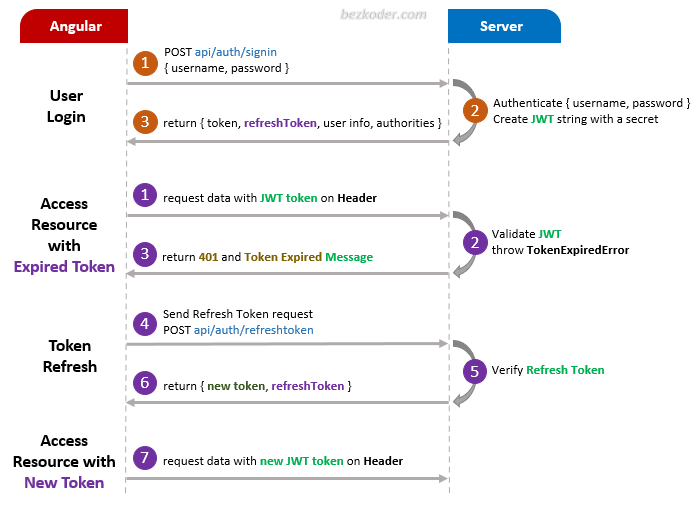
– A refreshToken will be provided at the time user signs in.
– A legal JWT must be added to HTTP Header if Angular 12 Client accesses protected resources.
– With the help of Http Interceptor, Angular App can check if the accessToken (JWT) is expired (401), sends /refreshToken request to receive new accessToken and use it for new resource request.
Let’s see how the Angular Refresh Token example works with demo UI.
– User signs in with a legal account first.
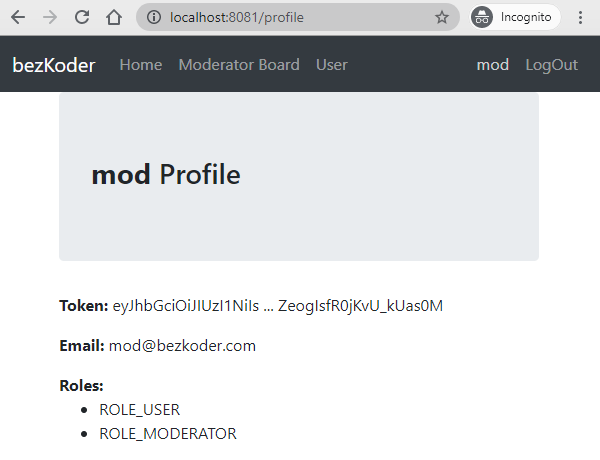
– Now the user can access resources with provided Access Token.
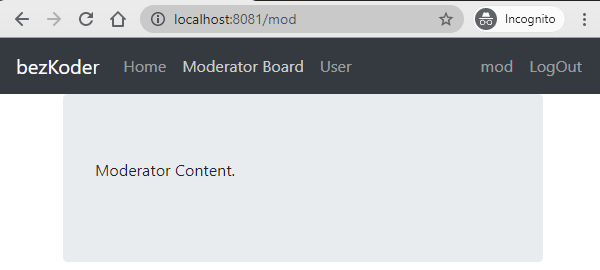
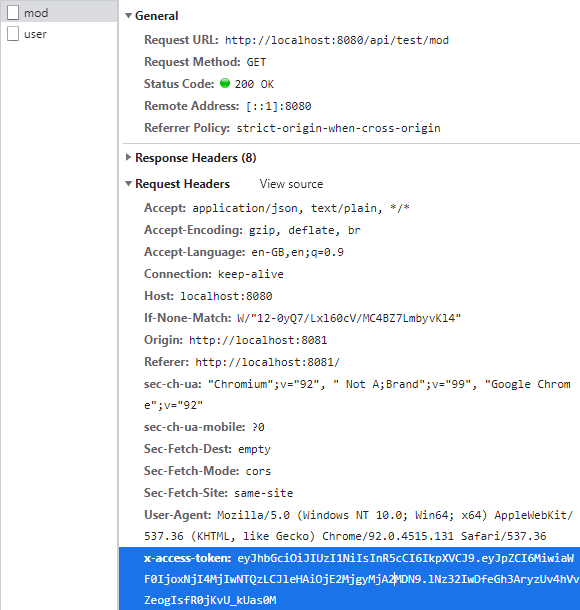
– When the Access Token is expired, Angular automatically sends Refresh Token request, receives new Access Token and uses it for new request.
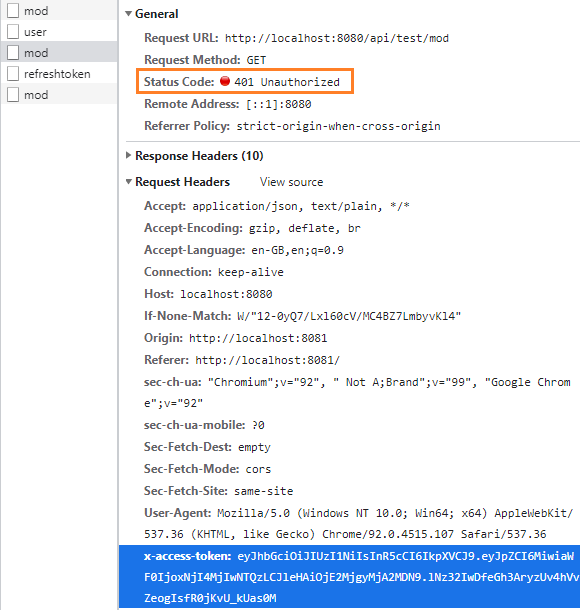
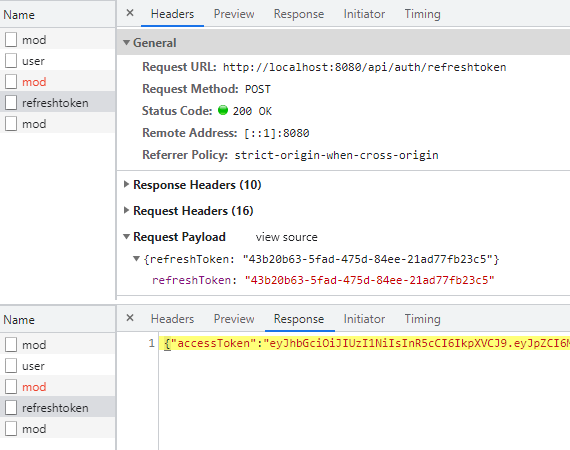
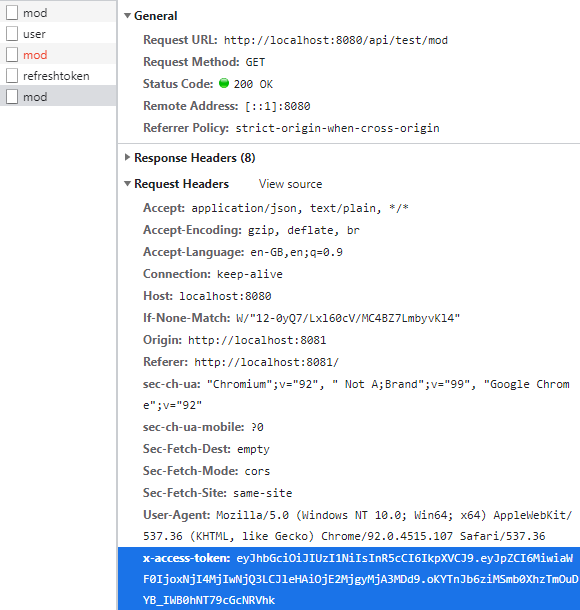
So the server still accepts resource access from the user.

– After a period of time, the new Access Token is expired again, and the Refresh Token too. Our App forces logout the user.
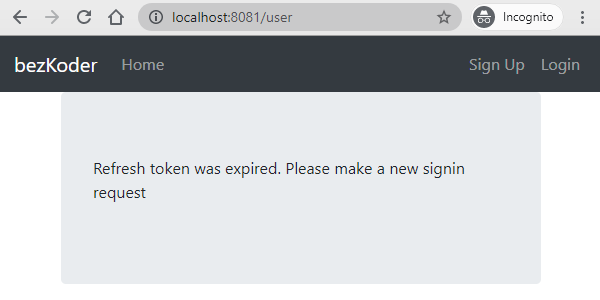
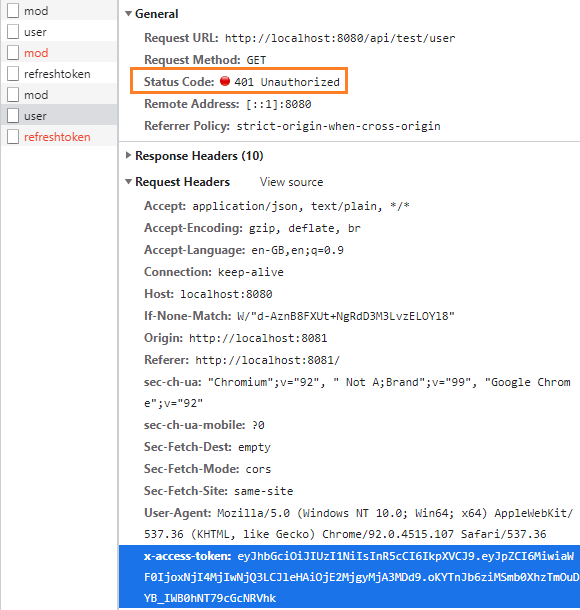
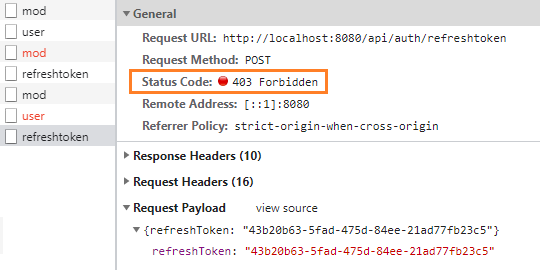
We’re gonna implement Token Refresh feature basing on the code from previous posts, so you need to read following tutorial first:
Angular 12 Login and Registration example with JWT & Web Api
Add Refresh Token function in Angular Service
Firstly, we need to create refreshToken() function that uses HttpClient to send HTTP Request with refreshToken in the body.
_services/auth.service.ts
import { Injectable } from '@angular/core';
import { HttpClient, HttpHeaders } from '@angular/common/http';
import { Observable } from 'rxjs';
const AUTH_API = 'http://localhost:8080/api/auth/';
const httpOptions = {
headers: new HttpHeaders({ 'Content-Type': 'application/json' })
};
@Injectable({
providedIn: 'root'
})
export class AuthService {
constructor(private http: HttpClient) { }
// login, register
refreshToken(token: string) {
return this.http.post(AUTH_API + 'refreshtoken', {
refreshToken: token
}, httpOptions);
}
}
We also need to update token-storage.service.ts which provides get, set, remove methods to work with Access Token, Refresh Token and User Data stored on Browser.
_services/token.service.ts
import { Injectable } from '@angular/core';
const TOKEN_KEY = 'auth-token';
const REFRESHTOKEN_KEY = 'auth-refreshtoken';
const USER_KEY = 'auth-user';
@Injectable({
providedIn: 'root'
})
export class TokenStorageService {
constructor() { }
signOut(): void {
window.sessionStorage.clear();
}
public saveToken(token: string): void {
window.sessionStorage.removeItem(TOKEN_KEY);
window.sessionStorage.setItem(TOKEN_KEY, token);
const user = this.getUser();
if (user.id) {
this.saveUser({ ...user, accessToken: token });
}
}
public getToken(): string | null {
return window.sessionStorage.getItem(TOKEN_KEY);
}
public saveRefreshToken(token: string): void {
window.sessionStorage.removeItem(REFRESHTOKEN_KEY);
window.sessionStorage.setItem(REFRESHTOKEN_KEY, token);
}
public getRefreshToken(): string | null {
return window.sessionStorage.getItem(REFRESHTOKEN_KEY);
}
public saveUser(user: any): void {
window.sessionStorage.removeItem(USER_KEY);
window.sessionStorage.setItem(USER_KEY, JSON.stringify(user));
}
public getUser(): any {
const user = window.sessionStorage.getItem(USER_KEY);
if (user) {
return JSON.parse(user);
}
return {};
}
}
Angular 12 Refresh Token with Interceptor
To implement refresh token, we need to follow 2 steps:
- save the Refresh Token right after making login request (which returns Access Token and Refresh Token).
- use Angular
HttpInterceptorto check401status in the response and callAuthService.refreshToken()with saved Refresh Token above.
Save Refresh Token after Login
In LoginComponent, we update onSubmit() functiob with new TokenStorageService‘s saveRefreshToken() method.
login/login.component.ts
...
import { TokenStorageService } from '../_services/token-storage.service';
...
export class LoginComponent implements OnInit {
...
constructor(private authService: AuthService, private tokenStorage: TokenStorageService) { }
...
onSubmit(): void {
const { username, password } = this.form;
this.authService.login(username, password).subscribe(
data => {
this.tokenStorage.saveToken(data.accessToken);
this.tokenStorage.saveRefreshToken(data.refreshToken);
this.tokenStorage.saveUser(data);
...
},
err => {
this.errorMessage = err.error.message;
this.isLoginFailed = true;
}
);
}
...
}
Angular Http Interceptor with 401 status for Refresh Token
We’re gonna silent refresh JWT Token using Angular HttpInterceptor when receiving response with status code 401.
_helpers/auth.interceptor.ts
import { HTTP_INTERCEPTORS, HttpEvent, HttpErrorResponse } from '@angular/common/http';
import { Injectable } from '@angular/core';
import { HttpInterceptor, HttpHandler, HttpRequest } from '@angular/common/http';
import { TokenStorageService } from '../_services/token-storage.service';
import { AuthService } from '../_services/auth.service';
import { BehaviorSubject, Observable, throwError } from 'rxjs';
import { catchError, filter, switchMap, take } from 'rxjs/operators';
// const TOKEN_HEADER_KEY = 'Authorization'; // for Spring Boot back-end
const TOKEN_HEADER_KEY = 'x-access-token'; // for Node.js Express back-end
@Injectable()
export class AuthInterceptor implements HttpInterceptor {
private isRefreshing = false;
private refreshTokenSubject: BehaviorSubject<any> = new BehaviorSubject<any>(null);
constructor(private tokenService: TokenStorageService, private authService: AuthService) { }
intercept(req: HttpRequest<any>, next: HttpHandler): Observable<HttpEvent<Object>> {
let authReq = req;
const token = this.tokenService.getToken();
if (token != null) {
authReq = this.addTokenHeader(req, token);
}
return next.handle(authReq).pipe(catchError(error => {
if (error instanceof HttpErrorResponse && !authReq.url.includes('auth/signin') && error.status === 401) {
return this.handle401Error(authReq, next);
}
return throwError(error);
}));
}
private handle401Error(request: HttpRequest<any>, next: HttpHandler) {
if (!this.isRefreshing) {
this.isRefreshing = true;
this.refreshTokenSubject.next(null);
const token = this.tokenService.getRefreshToken();
if (token)
return this.authService.refreshToken(token).pipe(
switchMap((token: any) => {
this.isRefreshing = false;
this.tokenService.saveToken(token.accessToken);
this.refreshTokenSubject.next(token.accessToken);
return next.handle(this.addTokenHeader(request, token.accessToken));
}),
catchError((err) => {
this.isRefreshing = false;
this.tokenService.signOut();
return throwError(err);
})
);
}
return this.refreshTokenSubject.pipe(
filter(token => token !== null),
take(1),
switchMap((token) => next.handle(this.addTokenHeader(request, token)))
);
}
private addTokenHeader(request: HttpRequest<any>, token: string) {
/* for Spring Boot back-end */
// return request.clone({ headers: request.headers.set(TOKEN_HEADER_KEY, 'Bearer ' + token) });
/* for Node.js Express back-end */
return request.clone({ headers: request.headers.set(TOKEN_HEADER_KEY, token) });
}
}
export const authInterceptorProviders = [
{ provide: HTTP_INTERCEPTORS, useClass: AuthInterceptor, multi: true }
];
In the code above, we:
– intercept requests or responses before they are handled by intercept() method.
– handle 401 status on interceptor response (except response of /login request)
– use refreshTokenSubject to track the current refresh token value. It is null if no token is currently available.
For example, when the refresh progress is processing (isRefreshing = true), we will wait until refreshTokenSubject has a non-null value (new Access Token is ready and we can retry the request again).
How to handle Token expiration in Angular 12
We will dispatch logout event to App component when response status tells us the access token is expired and refresh token too.
First we need to set up a global event-driven system, or a PubSub system, which allows us to listen and dispatch (emit) events from independent components so that they don’t have direct dependencies between each other.
We’re gonna create EventBusService with three methods: on, and emit.
_shared/event-bus.service.ts
import { Injectable } from '@angular/core';
import { Subject, Subscription } from 'rxjs';
import { filter, map } from 'rxjs/operators';
import { EventData } from './event.class';
@Injectable({
providedIn: 'root'
})
export class EventBusService {
private subject$ = new Subject<EventData>();
constructor() { }
emit(event: EventData) {
this.subject$.next(event);
}
on(eventName: string, action: any): Subscription {
return this.subject$.pipe(
filter((e: EventData) => e.name === eventName),
map((e: EventData) => e["value"])).subscribe(action);
}
}
_shared/event.class.ts
export class EventData {
name: string;
value: any;
constructor(name: string, value: any) {
this.name = name;
this.value = value;
}
}
Now you can emit event to the bus and if any listener was registered with the eventName, it will execute the callback function action.
Next we import EventBusService in App component and listen to "logout" event.
src/app.component.ts
import { Component, OnInit, OnDestroy } from '@angular/core';
import { Subscription } from 'rxjs';
import { TokenStorageService } from './_services/token-storage.service';
import { EventBusService } from './_shared/event-bus.service';
@Component({
selector: 'app-root',
templateUrl: './app.component.html',
styleUrls: ['./app.component.css']
})
export class AppComponent implements OnInit, OnDestroy {
private roles: string[] = [];
isLoggedIn = false;
showAdminBoard = false;
showModeratorBoard = false;
username?: string;
eventBusSub?: Subscription;
constructor(private tokenStorageService: TokenStorageService, private eventBusService: EventBusService) { }
ngOnInit(): void {
this.isLoggedIn = !!this.tokenStorageService.getToken();
if (this.isLoggedIn) {
const user = this.tokenStorageService.getUser();
this.roles = user.roles;
this.showAdminBoard = this.roles.includes('ROLE_ADMIN');
this.showModeratorBoard = this.roles.includes('ROLE_MODERATOR');
this.username = user.username;
}
this.eventBusSub = this.eventBusService.on('logout', () => {
this.logout();
});
}
ngOnDestroy(): void {
if (this.eventBusSub)
this.eventBusSub.unsubscribe();
}
logout(): void {
this.tokenStorageService.signOut();
this.isLoggedIn = false;
this.roles = [];
this.showAdminBoard = false;
this.showModeratorBoard = false;
}
}
Finally we only need to emit "logout" event in the components when getting Unauthorized response status (403).
components/board-user.component.ts
import { Component, OnInit } from '@angular/core';
import { UserService } from '../_services/user.service';
import { EventBusService } from '../_shared/event-bus.service';
import { EventData } from '../_shared/event.class';
...
export class BoardUserComponent implements OnInit {
content?: string;
constructor(private userService: UserService, private eventBusService: EventBusService) { }
ngOnInit(): void {
this.userService.getUserBoard().subscribe(
data => { ... },
err => {
this.content = err.error.message || err.error || err.message;
if (err.status === 403)
this.eventBusService.emit(new EventData('logout', null));
}
);
}
}
Conclusion
Today we know how to implement Angular 12 JWT Refresh Token before expiration using Http Interceptor with 401 status code.
Không có nhận xét nào:
Đăng nhận xét